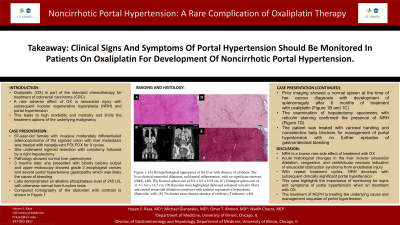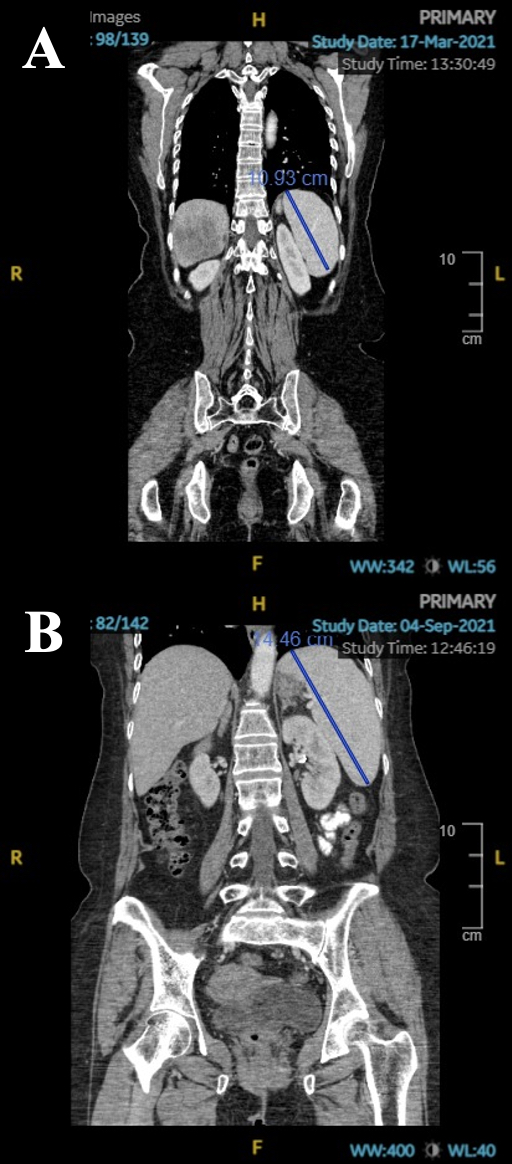Sunday Poster Session
Category: Liver
P1273 - Noncirrhotic Portal Hypertension: A Rare Complication of Oxaliplatin-Based Chemotherapy
Sunday, October 27, 2024
3:30 PM - 7:00 PM ET
Location: Exhibit Hall E

Has Audio
- HR
Hasan S. Raza, MD
University of Illinois
Chicago, IL
Presenting Author(s)
Hasan S. Raza, MD1, Michael Gianarakis, MD2, Omar T. Ahmed, MD2, Wadih Chacra, MD3
1University of Illinois, Chicago, IL; 2University of Illinois at Chicago, Chicago, IL; 3University of Illinois College of Medicine, Chicago, IL
Introduction: Oxaliplatin (OX) is part of the standard chemotherapy (eg, FOLFOX) for treatment of colorectal carcinoma (CRC). A rare adverse effect of OX is sinusoidal injury with subsequent nodular regenerative hyperplasia (NRH) and portal hypertension. This leads to high morbidity and mortality and limits the treatment options of the underlying malignancy. Here, we present a unique case of a patient on OX with rapid development of non-cirrhotic portal hypertension (NCPH) with clinical and radiological manifestations.
Case Description/Methods: A 67-year-old female with invasive moderately differentiated adenocarcinoma of the sigmoid colon with liver metastasis treated with neoadjuvant FOLFOX and bevacizumab for 9 cycles was switched to irinotecan/capecitabine/bevacizumab due to neuropathy with favorable response. She underwent sigmoid resection with colostomy followed by a right hepatectomy. Pathology showed normal liver parenchyma. 3 months later, she presented with bloody ostomy output. Upper endoscopy showed grade 3 esophageal varices and severe portal hypertensive gastropathy which was likely the cause of bleeding. Labs demonstrated an alkaline phosphatase level of 245 U/L with otherwise normal liver function tests. Computed tomography of the abdomen with contrast demonstrated patent portal and splenic veins with a new finding of splenomegaly, indicating the development of portal hypertension. Prior imaging showed a normal spleen at the time of her cancer diagnosis with development of splenomegaly after 6 months of treatment with oxaliplatin (Figure 1A and 1B). The examination of hepatectomy specimens with reticulin staining confirmed the presence of NRH. The patient was treated with variceal banding and nonselective beta blockers for management of portal hypertension with no further episodes of gastrointestinal bleeding.
Discussion: NRH is a known rare side effect of treatment with OX. Acute histological changes in the liver include sinusoidal dilatation, congestion, and centrilobular necrosis indicative of sinusoidal obstruction syndrome from endothelial injury. With repeat treatment cycles, NRH develops with subsequent clinically significant portal hypertension as seen in our patient. This case highlights the importance of monitoring for signs and symptoms of portal hypertension when on treatment with OX. The treatment of NCPH in this case requires holding OX to prevent progression along with nonselective beta blockers with or without variceal band ligation when indicated.

Disclosures:
Hasan S. Raza, MD1, Michael Gianarakis, MD2, Omar T. Ahmed, MD2, Wadih Chacra, MD3. P1273 - Noncirrhotic Portal Hypertension: A Rare Complication of Oxaliplatin-Based Chemotherapy, ACG 2024 Annual Scientific Meeting Abstracts. Philadelphia, PA: American College of Gastroenterology.
1University of Illinois, Chicago, IL; 2University of Illinois at Chicago, Chicago, IL; 3University of Illinois College of Medicine, Chicago, IL
Introduction: Oxaliplatin (OX) is part of the standard chemotherapy (eg, FOLFOX) for treatment of colorectal carcinoma (CRC). A rare adverse effect of OX is sinusoidal injury with subsequent nodular regenerative hyperplasia (NRH) and portal hypertension. This leads to high morbidity and mortality and limits the treatment options of the underlying malignancy. Here, we present a unique case of a patient on OX with rapid development of non-cirrhotic portal hypertension (NCPH) with clinical and radiological manifestations.
Case Description/Methods: A 67-year-old female with invasive moderately differentiated adenocarcinoma of the sigmoid colon with liver metastasis treated with neoadjuvant FOLFOX and bevacizumab for 9 cycles was switched to irinotecan/capecitabine/bevacizumab due to neuropathy with favorable response. She underwent sigmoid resection with colostomy followed by a right hepatectomy. Pathology showed normal liver parenchyma. 3 months later, she presented with bloody ostomy output. Upper endoscopy showed grade 3 esophageal varices and severe portal hypertensive gastropathy which was likely the cause of bleeding. Labs demonstrated an alkaline phosphatase level of 245 U/L with otherwise normal liver function tests. Computed tomography of the abdomen with contrast demonstrated patent portal and splenic veins with a new finding of splenomegaly, indicating the development of portal hypertension. Prior imaging showed a normal spleen at the time of her cancer diagnosis with development of splenomegaly after 6 months of treatment with oxaliplatin (Figure 1A and 1B). The examination of hepatectomy specimens with reticulin staining confirmed the presence of NRH. The patient was treated with variceal banding and nonselective beta blockers for management of portal hypertension with no further episodes of gastrointestinal bleeding.
Discussion: NRH is a known rare side effect of treatment with OX. Acute histological changes in the liver include sinusoidal dilatation, congestion, and centrilobular necrosis indicative of sinusoidal obstruction syndrome from endothelial injury. With repeat treatment cycles, NRH develops with subsequent clinically significant portal hypertension as seen in our patient. This case highlights the importance of monitoring for signs and symptoms of portal hypertension when on treatment with OX. The treatment of NCPH in this case requires holding OX to prevent progression along with nonselective beta blockers with or without variceal band ligation when indicated.

Figure: (A) CT imaging at the time of starting OX-based chemotherapy with normal spleen size. (B) Development of splenomegaly 6 months after starting OX-based chemotherapy.
Disclosures:
Hasan Raza indicated no relevant financial relationships.
Michael Gianarakis indicated no relevant financial relationships.
Omar Ahmed indicated no relevant financial relationships.
Wadih Chacra indicated no relevant financial relationships.
Hasan S. Raza, MD1, Michael Gianarakis, MD2, Omar T. Ahmed, MD2, Wadih Chacra, MD3. P1273 - Noncirrhotic Portal Hypertension: A Rare Complication of Oxaliplatin-Based Chemotherapy, ACG 2024 Annual Scientific Meeting Abstracts. Philadelphia, PA: American College of Gastroenterology.
